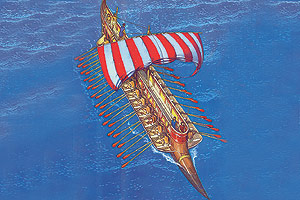The Phoenician city-states succeeded in creating their own commercial structure with the help of their privileged geographic position, situated on the shores of the Mediterranean. The first merchandise they sold was purple dyed fabrics. They amassed great fortunes from this and the creation of new maritime trade routes, using these fortunes to invest in trading and war ships. Here their expansion began as did the foundation of colonies and trading posts which would later act as bridges linking the civilizations of East and the peoples of the West. Trade was based on interchange and it took place by way of transactions known as «mute bartering», which was an original way to negotiate without having direct contact with buyers. Merchants came close to the coast, left their products on the edge of the beach and returned to their ships, where they waited for the inhabitants to come and examine the merchandise and place next to it the amount in spices they deemed appropriate. Once the offer had been made, the Phoenicians once again returned to the beach, and if they considered the amount offered adequate, they took it and left the merchandise. But if the amount offered was not satisfactory, they went boarded again to wait for another proposal. All this was mainly because the peoples they traded with were not familiar with the use of currency.
Colonial expansion
The Phoenician’s advances in the construction of merchant ships and their skill in using the stars for navigation allowed the Phoenicians to embark on an expansion process throughout the Mediterranean which ended in a true thalassocracy, the economic and political hegemony of a people over the seas.
The island of Cyprus was the first place to be colonised in this process with the conquest of the Cypriot cities of Idalium, Tamasos, Golgoi, Marion and Lapethos. All of these were important centres of the manufacture and production of ceramics, bronzes, jewellery and furniture, among other products. Afterwards was Rhodes and almost all of the islands of the Aegean Sea. Nevertheless, it is appropriate to mention that Cyprus became the nucleus of maritime trade in the Eastern Mediterranean.
In the Central and Western Mediterranean, Phoenician colonisation developed in stages. Firstly, expeditions established small commercial trading posts in Motya and Malta etc. Afterwards, resulting from the Assyrian invasion of the most important Phoenician cities, many of their inhabitants emigrated to some those trading posts, promoting strong demographic growth and, as a result, the necessity to found other colonies.
Carthage, located on a peninsula in the Gulf of Tunis became the largest and most powerful Phoenician colony due to its strategic position as a compulsory stopover for ships coming from Gades and heading to Tyre. In Sardinia there was a large population base. The great ports, such as Caralis, Tharros, Nora and Sulcis, were the base of Phoenician expansion into the Western Mediterranean. The main objectives of Gades in the Iberian peninsula were oriented towards the riches which came from their nearest territory, Tartessos, and controlling access to the Atlantic route through the Gibraltar straight, where the Poenicians obtained tin, gold and ivory from the colony of Lixos.
The decline of the empire
Phoenicia’s economic glory was threatened from the beginning of the 9th Century B.C., when the Assyrians, who needed access to the sea to strengthen their political position in the Near East, began making incursions into the region. The King Asurnasirpal of Assyria extended his influence to Byblos, Sidon and Tyre, upon which he imposed harsh tributes. This domination forced the Phoenician cities to form an alliance, but Tyre and Sidon opposed this.
In the 6th Century B.C., King Nebuchadrezzar II invaded Tyre. The city resisted heroically, but it fell after thirteen years in 572 B.C. From then on, Sidon came to exercise supremacy over the Phoenician cities and collaborated with the Persian Empire against the Greeks, their main enemies in the struggle for the control over the Mediterranean. The Persians included the Phoenicias in their fifth satrapy (province), together with Palestine and Cyprus. Sidon then tried moving closer to the Greeks, but without success. In 332 B.C. the majority of Phoenician cities opened their gates without resistance to the armies of Alexander the Great. Nevertheless, Tyre once again put up the fiercest and longest lasting resistance, but, exhausted after so many years of struggle, the city ended up being taken by Alexander. Thus, the Phoenician people, conquered by the Greeks, lost their political independence. Despite this, the traces of their culture persisted and only disappeared when Rome incorporated them into its new territory in 64 B.C.








 Muere Evita
Muere Evita